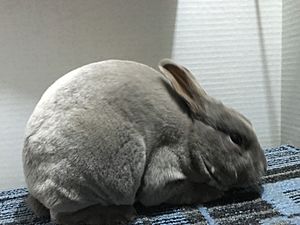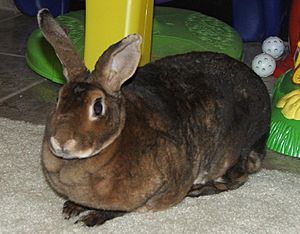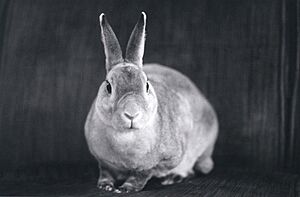Mini Rex facts for kids
The Mini Rex is a popular type of domestic rabbit. It was first created in 1984 in Florida by Monna Berryhill from Texas. These rabbits have a unique fur type because of a special gene. This gene, which is recessive (meaning a rabbit needs two copies of it to show the trait), makes their hair stand outwards instead of lying flat. It also makes their guard hairs (the longer, stiffer hairs) as short as their soft undercoat. This gives them a super soft, plush-like fur!
Mini Rex rabbits are loved for their small size, their incredibly soft coats, and their friendly personalities. They are one of the most popular rabbit breeds in the United States. The American Rabbit Breeders Association (ARBA) officially recognized them in 1988. Since then, they have been a favorite among rabbit exhibitors. When fully grown, Mini Rex rabbits usually weigh between 3.5 and 4 pounds. They are short and compact. Their fur is ideally about 5/8 of an inch long. It looks shiny and feels springy and plush when you touch it.
Contents
What Makes a Mini Rex Special?
Body and Fur Standards
For rabbit shows and competitions, a Mini Rex should have a nicely rounded back. Their shoulders, middle section, and hindquarters should be well-developed. Their head should be full and sit on a short neck. Their ears should be thick and no longer than 3.5 inches. They should have medium-fine bones and fairly short legs.
The fur is very important for a Mini Rex. It should be super dense, straight, and stand upright. It needs to feel smooth and springy, not too soft or silky. The fur length must be between 1/2 inch and 7/8 inch. If a rabbit is missing any toenails, it can be disqualified from a show.
Showing Your Mini Rex
Mini Rex rabbits are judged on different features to get a total score out of 100 points. The body is worth 45 points, the head 6 points, and the ears 5 points. Their special fur is worth 35 points, their color 15 points, and their overall condition 5 points.
Rabbits are shown in four different age and weight groups:
- Senior Bucks: Male rabbits over 6 months old, weighing 3 to 4.25 pounds (ideal is 4 pounds).
- Senior Does: Female rabbits over 6 months old, weighing 3.25 to 4.5 pounds (ideal is 4.25 pounds).
- Junior Bucks: Male rabbits under 6 months old, weighing 2 to 3.25 pounds.
- Junior Does: Female rabbits under 6 months old, weighing 2 to 3.75 pounds.
If a junior rabbit weighs more than its group allows, it can be shown in a higher age group. However, a rabbit can never be shown in a younger age group than its true age.
Many Mini Rex rabbit shows happen locally or nationally. Some shows are organized by local or state rabbit clubs, not just the ARBA. Judges from around the country evaluate the rabbits, and winners are announced. Rabbit classes are divided by color, age, and gender. Sometimes, if not enough rabbits are entered in a class, it might be canceled. Rabbits can win a "leg" at sanctioned shows. A "leg" is a special win awarded when there are 5 or more rabbits in a class from 3 or more different owners. These "legs" can be for different awards like Best in Show (BIS), Best of Breed (BOB), Best Opposite Sex (BOS), Best of Variety (BOV), or Best Opposite Sex of Variety (BOSV).
Mini Rex Colors and Patterns
Mini Rex rabbits come in many beautiful colors and patterns. In 2012, the Smoke Pearl color was accepted. In 2017, the Sable Mini Rex became a new recognized color. There are also new colors like the Tan Mini Rex being developed!
Here are some of the accepted colors for Mini Rex rabbits:
- Black – A deep, shiny black color all over, with a dark blue undercoat. They have dark brown eyes.
- Blue – A dark blue color that goes deep into the fur, with a medium blue undercoat. Their eyes are bluish-grey.
- Castor – A rich chestnut color with black tips on the fur. The undercoat can be slate blue or white with an orange band. Their ears have black lacing. Their belly, eye circles, and jowls are cream. Eyes are brown or black with a blue tint.
- Chinchilla – A sparkling mix of pearl and black, looking like a real chinchilla. They have a slate blue undercoat and a white belly. Their ears are laced with black, and their eye circles are pearl. The top of their tail is black, and the bottom is white. Eyes are brown or bluish-grey.
- Chocolate – A shiny chocolate brown color with a dove-grey undercoat. They have brown eyes.
- Himalayan – A bright white body with dark blue or black ears, feet, tail, and nose. They have dark toenails and pink eyes.
- Lilac – A dove-grey color with a light lilac tint. They have matching toenails and bluish-grey eyes.
- Lynx – A light fawn color with lilac tips on the fur. They have a white undercoat. Their eye circles, jowls, belly, inside of ears, and underside of the tail are white. The stomach should have a lilac undercolor that doesn't spread to the sides. Eyes are bluish-grey.
- Silver Marten - These rabbits can be black, blue, chocolate, or lilac. They have white or silver on their belly, chin, tail, behind their ears, and around their eyes.
- Opal – A medium blue top color, a fawn color in the middle, and a grayish-blue undercoat. The underside of their tail, jowls, belly, inside of ears, and eye circles are white or cream. Eyes are bluish-grey.
- Otter – These can be black, blue, chocolate, or lilac. They have cream color around their eyes and on their stomachs, with the right undercoat color (e.g., Black Otters have a cream stomach with a slate undercoat). They also have reddish-brown markings lacing their ears, behind their neck, on their inner thighs, and outlining their stomach.
- Red – A rich red color with as little shading as possible. They have a white or cream belly. Eyes are brown.
- Sable – A rich sepia brown color that gets lighter on the sides, chest, belly, inside of legs, and underside of the tail. Eyes are brown.
- Sable Point – Lighter brown all over, with darker ears, nose, tail, and feet. Eyes are brown.
- Seal – A very dark brown body that fades to a lighter brown on the belly and chest. Eyes are brown.
- Tortoise – A rich orange color with dark shading on the belly, feet, rear, sides, face, and ears. Eyes are brown.
- Red-Eyed White – Pure white fur with pink eyes.
- Blue-Eyed White – Pure white fur with blue eyes.
- Broken – Any accepted color mixed with white patches.
- Tri-Color – White with two other colors: Black & Orange, Lilac & Fawn, Chocolate & Orange, or Blue & Fawn.
- Pattern – A Broken rabbit with balanced markings on its nose, eyes, colored ears, colored tail, and colored body spots. The colored areas should cover 10% to 50% of the rabbit's body.
Note: Tri-color rabbits are shown in the Broken class.





